Intention to Attend Business School in Thailand
Keywords:
Theory of Planned Behavior, Intention; Behavior, Business School, ThailandAbstract
This paper examines the effects of motivation on attending business school in Thailand based on the theory of planned behavior (TPB) as the theoretical foundation. The direct and indirect effects of motivation on behavior via intention were examined in Thailand business school context. A quantitative research methodology was used in this study. Data were collected using a self-administered questionnaire and distributed to 400 first year business school students in Thailand. For data analysis, a confirmatory factor analysis (CFA) was used in measurement model verification while a structural equation modeling (SEM) was conducted in structural model verification and hypotheses testing. The positive significant indirect effects of motivations (Attitude and Subjective Norms) on behavior via intention are revealed with statistical significance at 0.01. This study is among the first that extended the TPB and applied the findings in Thailand business school context.
References
Ajzen, I., & Fishbein, M. (1980). Understanding attitudes and predicting social behavior. USA: Prentice Hall.
Chan, K., & Tsang, L. (2011). Promote healthy eating among adolescents: A Hong Kong study. Journal of Consumer Marketing, 28(5), 354-362.
Cheng, E. W. L., Sanders, K., & Hampson, I. (2015). An intention-based model of transfter of training. Management Research Review, 38(8), 908-928.
Deepana, A., Numkham, L., & Wattanasoei, S. (2018). Factors affecting intention to alcohol abstinence among the department store employees in Nan province. Thai Science and Technology Journal, 28(1), 168-181.
Farooq, M. S. (2018). Modelling the significance of social support and entrepreneurial skills for determining entrepreneurial behaviour of individuals: A structural equation modelling approach. World Journal of Entrepreneurship, Management and Sustainable Development, 14(3), 242-266.
Fornell, C., & Larker D. F. (1981). Structural equation models with unobservable variables and measurement error: Algebra and statistics. Journal of Marketing Research, 18, 382-388.
Fulham, E., & Mullan, B. (2011). Hygienic food handling behaviors: Attempting to bridge the intentionbehavior gap using aspects from tempora self-regulation theory. Journal of Food Protection, 74(6), 925-932.
Hair, J. F., Black, W. C., Babin, B. J., Anderson, R. E. & Tatham, R. L. (2006). Multivariate Data Analysis. USA: Prentice Hall.
Iakovleva, T., Kolvereid, L., & Stephan, U. (2011). Entrepreneurial intentions in developing and developed countries. Education + Training, 53(5), 353-370.
Jain, S., Khan, M. N., & Mishra, S. (2017). Understanding consumer behavior regarding luxury fashion goods in India based on the theory of planned behavior. Journal of Asia Business Studies, 11(1), 4-21.
Joreskog, K. G., & Sorbom, D. (1996). LISREL 8: User’s Reference Guide. USA: SSI Scientific Software International.
Kanjanarach, T., Jaisa-ard, R., & Buppasiri, M. (2014). Factors influencing the intention for the consumption of calcium-containing food among lower secondary school students in Khon Kaen province. Isan Journal of Pharmaceutical Sciences, 10(3), 322-338.
Kim, M. S., & James, J. (2016). The theory of planned behaviour and intention of purchase sport team licensed merchandise. Sport, Business and Management: An International Journal, 6(2), 228-243.
Office of the Higher Education Commission. (2019). From web site: https://www.mua.go.th
Office of the National Economic and Social Development Council. (2019). From web site: https://www.nesdc.go.th
Paha, K., & Prechawong, S. (2014). Attitudes, subjective norms, perceive behavioral control, and intention to quit smoking in police officers. Journal of The Police Nurse, 6(1), 157-169.
Punjam, P., & Akkawanitcha, C. (2015). Factors affecting on green product consumption behavior. Veridian E-Journal, Silpakorn Univeristy, 11(2), 2266-2281.
Scannell, T. V., Calantone, R. J., & Melnyk, S. A. (2012). Shop floor manufacturing technology adoption decisions: An application of the theory of planned behavior. Journal of Manufacturing Technology Management, 23(4), 464-483.
Solesvik, M. Z., Westhead, P., Kolvereid, L., & Matlay, H. (2012). Student intentions to become self_ employed: the Ukrainian context. Journal of Small Business and Enterprise Development, 19(3), 441-460.
Srivichai, C. (2014). Health behavior in game addiction of early adolescents: A planned behavior theory. Journal of The Police Nurse, 6(2), 1-15.
Sun, H., Lo, C. T., Liang, B., & Wong, Y. L. B. (2017). The impact of entrepreneurial education on entrepreneurial intention of engineering students in Hong Kong. Management Decision, 55(7), 1371-1393.
Tepsuriyanont, S. (2017). A causal model of medication adherence behavior among hypertensive adult patients. Journal of Nursing and Education, 10(1), 1-15.
Thoradeniya, P., Lee, J., Tan, R., & Ferreira, A. (2015). Sustainability reporting and the theory of planned behaviour. Accounting, Auditing & Accountability Journal, 28(7), 1099-1137.
Tiwari, P., Bhat, A. K., & Tikoria, J. (2017). Predictors of social entrepreneurial intention: An empirical study. South Asian Journal of Business Studies, 6(1), 53-79.
Wang, J., Chu, M., Deng, Y. Y., Lam, H., & Tang, J. (2018). Determinants of pesticide application: An empirical analysis with theory of planned behaviour. China Agricultural Economic Review, 10(4), 608-625.
Yamane, T. (1967). Statistics, An Introductory Analysis. 2nd Edition. USA: Harper and Row.
Yusof, N. A. M., & Lai, M. L. (2014). An integrative model in predicting corporate tax fraud. Journal of Financial Crime, 21(4), 424-432.
Yuttatri, P., & Junyaem, U. (2015). Factors predicting intention to non-drinking among undergraduate students from one university in southern Thailand. Journal of Public Health, 45(2), 171-183.
Downloads
Published
How to Cite
Issue
Section
License

This work is licensed under a Creative Commons Attribution-NonCommercial-NoDerivatives 4.0 International License.




